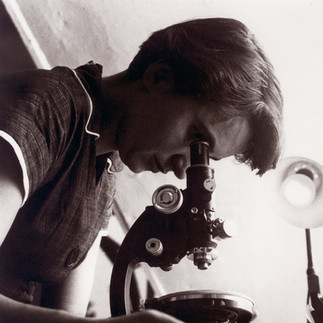Rosalind Franklin: The Secret of Life
- Tina
- Feb 9, 2024
- 2 min read
Hello everyone! I'm Tina and this is Women Weekly, where I post about one wonderful woman in the STEM field every Friday. This week, you'll read about a less famous, yet equal player in the discovery of DNA's structure – Rosalind Franklin.
Rosalind Franklin was born in 1920 in London. She was the second oldest of five siblings in a prominent family. Rosalind was a great student, topped her classes, and won awards. In 1938, she passed her matriculation from St Paul's Girls' School and received a scholarship, which she then donated to a refugee student in need. That same year, Rosalind began studying chemistry at Newnham College, Cambridge. She won a research fellowship and joined the physical chemistry laboratory at Cambridge, but left after a year because of her unpleasant superior.
After the start of World War II, Rosalind volunteered as an Air Raid Warden and became an assistant research officer at the British Coal Utilisation Research Association. Her studies on the porosity of coal were useful in predicting which types are suitable for fuel or different wartime devices. She later based her Ph.D. thesis on her work here.
Through a friend of a friend, Rosalind met with Jacques Mering and got a researcher position at the Laboratoire Central des Services Chimiques de l'État in Paris. Thanks to Mering, she expanded her knowledge of X-ray crystallography, which later proved to be very useful to her.
In 1951, Rosalind started her work at King's College London. For her experience with X-ray diffraction, she was reassigned to research DNA with the assistance of Raymond Gosling. Using a modified X-ray tube, she discovered that DNA exists in two forms – 'crystalline' (A) and 'wet' (B). She chose the A-DNA for further research. With Gosling, they took a very patient approach. Refusing to speculate, they made pictures of the structure using X-ray diffraction. Photo 51, taken by Gosling, is the most famous of these pictures. Based on her data, she thought of the DNA as having a helical structure but wasn't yet sure whether it had two or three strands.
Her material, along with the material of Maurice Wilkins, greatly inspired James Watson and Francis Crick in their discovery, yet Rosalind was barely credited. To the contrary, Watson portrayed her as incapable of interpreting her own data in his famous memoir The Double Helix.
In 1953, Rosalind left for Birbeck College, where she conducted RNA research. With her team, she focused on viruses, especially TMV. Rosalind died in 1958 due to ovarian cancer and other conditions, her colleagues later finished her work on the polio virus.
Rosalind Franklin was a remarkable scientist. She greatly contributed to the discovery of DNA's structure, yet she did not get any recognition for it during her lifetime. So let's remember her now, as an equal player in the discovery of the secret of life.
Sources:
Information:
Images:






Comments